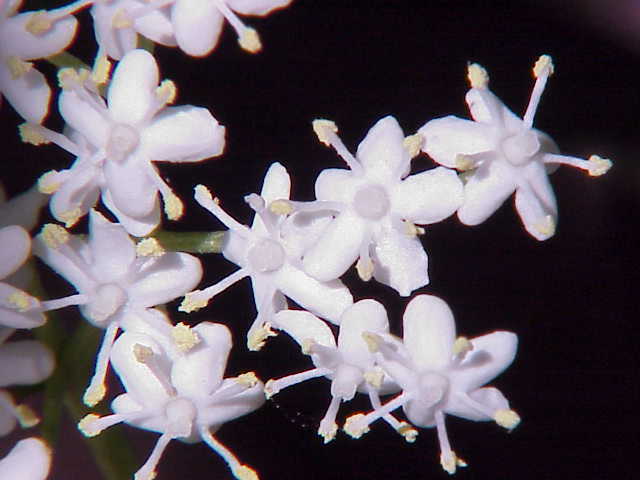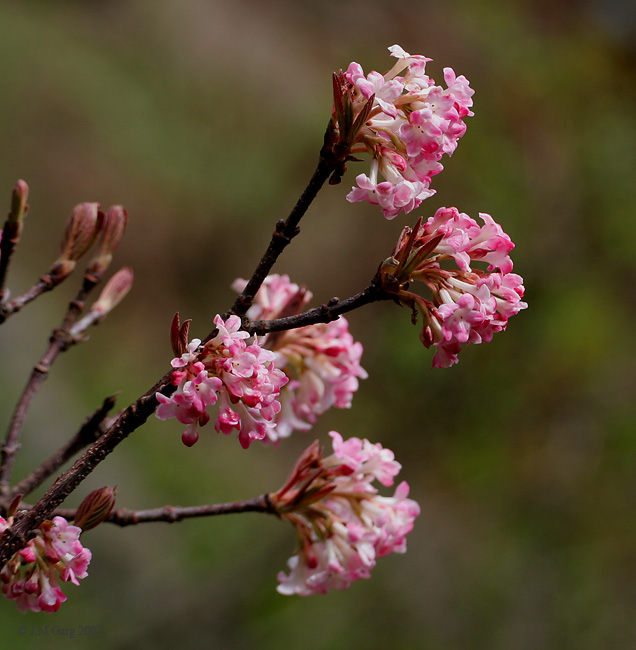|
Adoxaceae
Adoxaceae, commonly known as moschatel family, is a small family of flowering plants in the order Dipsacales, now consisting of five genera and about 150–200 species. They are characterised by opposite toothed leaves, small five- or, more rarely, four-petalled flowers in cymose inflorescences, and the fruit being a drupe. They are thus similar to many Cornaceae. In older classifications, this entire family was part of Caprifoliaceae, the honeysuckle family. '' Adoxa'' (moschatel) was the first plant to be moved to this new group. Much later, the genera ''Sambucus'' (elders) and ''Viburnum'' were added after careful morphological analysis and biochemical tests by the Angiosperm Phylogeny Group. An additional monotypic genus '' Sinadoxa'' has been added based on molecular comparison with '' Adoxa''. Recent sources, including the Angiosperm Phylogeny Website, treat this family as Viburnaceae Raf., ''nom. cons.'' ''Adoxa'' is a small perennial herbaceous plant, flowering earl ... [...More Info...] [...Related Items...] OR: [Wikipedia] [Google] [Baidu] |
Sambucus
''Sambucus'' is a genus of flowering plants in the family Adoxaceae. The various species are commonly called elder or elderberry. The genus was formerly placed in the honeysuckle family, Caprifoliaceae, but was reclassified as Adoxaceae due to genetic and morphological comparisons to plants in the genus '' Adoxa''. Description The oppositely arranged leaves are pinnate with 5–9 leaflets (or, rarely, 3 or 11). Each leaf is long, and the leaflets have serrated margins. They bear large clusters of small white or cream-colored flowers in late spring; these are followed by clusters of small black, blue-black, or red berries (rarely yellow or white). Color Sambucus fruit is rich in anthocyanidinsColors Derived from Agricultural Products |
Viburnum
''Viburnum'' is a genus of about 150–175 species of flowering plants in the moschatel family Adoxaceae. Its current classification is based on molecular phylogeny. It was previously included in the honeysuckle family Caprifoliaceae. The member species are evergreen or deciduous shrubs or (in a few cases) small trees native throughout the temperate Northern Hemisphere, with a few species extending into tropical montane regions in South America and southeast Asia. In Africa, the genus is confined to the Atlas Mountains. Name The generic name ''Viburnum'' originated in Latin, where it referred to '' V. lantana''. Description The leaves are opposite, simple, and entire, toothed or lobed; cool temperate species are deciduous, while most of the warm temperate species are evergreen. Some species are densely hairy on the shoots and leaves, with star-shaped hairs. The flowers are produced in corymbs 5–15 cm across, each flower white to cream or pink, small, 3–5&nbs ... [...More Info...] [...Related Items...] OR: [Wikipedia] [Google] [Baidu] |
Adoxa
''Adoxa'' is the type genus of flowering plants in the family Adoxaceae. It contains at least 2 species of flowering plant, including the moschatel, for which the family is named. *'' Adoxa moschatellina'' L. *'' Adoxa xizangensis'' G.Yao References Adoxaceae Dipsacales genera {{Dipsacales-stub ... [...More Info...] [...Related Items...] OR: [Wikipedia] [Google] [Baidu] |
Dipsacales
The Dipsacales are an order of flowering plants, included within the asterid group of dicotyledons. In the APG III system of 2009, the order includes only two families, Adoxaceae and a broadly defined Caprifoliaceae. Some well-known members of the Dipsacales order are honeysuckle, elder, viburnum, and valerian. Under the Cronquist system, the order included Adoxaceae, Caprifoliaceae sensu stricto, Dipsacaceae, and Valerianaceae. Under the 2003 APG II system, the circumscription of the order was much the same but the system allowed either a broadly circumscribed Caprifoliaceae including the families Diervillaceae, Dipsacaceae, Linnaeaceae, Morinaceae, and Valerianaceae, or these families being kept separate. The APG III system The APG III system of flowering plant classification is the third version of a modern, mostly molecular-based, system of plant taxonomy being developed by the Angiosperm Phylogeny Group (APG). Published in 2009, it was superseded in 2016 by a ... [...More Info...] [...Related Items...] OR: [Wikipedia] [Google] [Baidu] |
Viburnum Davidii
''Viburnum davidii'', the David viburnum, is a species of flowering plant in the family Adoxaceae native to western China. Growing to tall and broad, it is an evergreen shrub with large, glossy, oval leaves up to long. Each leaf is deeply veined lengthwise with three curved lines. Round clusters of tiny white flowers are produced in late spring, followed in late summer and autumn by oval blue fruits. Both male and female plants are required to produce fruit. ''V. davidii'' is one of several plants commemorating the 19th century French missionary and botanist Père Armand David. This plant has gained the Royal Horticultural Society's Award of Garden Merit The Award of Garden Merit (AGM) is a long-established annual award for plants by the British Royal Horticultural Society (RHS). It is based on assessment of the plants' performance under UK growing conditions. History The Award of Garden Merit .... Viburnum Berries.jpg, Fruit Viburnum davidii flowers.jpg, Flowers Re ... [...More Info...] [...Related Items...] OR: [Wikipedia] [Google] [Baidu] |
Sinadoxa
''Sinadoxa corydalifolia'' is the only species in the monotypic plant genus ''Sinadoxa'', in the family Adoxaceae. It is endemic to the Hengduan Mountains of the Tibetan Plateau in China. It is a perennial herb growing from a fibrous root system with rhizomes. It produces one to four upright, green stems up to 25 centimeters tall and just a few millimeters wide. The basal leaves are pinnate, made up of leaflets which may be lobed or subdivided. There is usually one opposite pair of leaves higher on the stem, each with three leaflets. The inflorescence An inflorescence is a group or cluster of flowers arranged on a stem that is composed of a main branch or a complicated arrangement of branches. Morphologically, it is the modified part of the shoot of seed plants where flowers are formed ... is a spike with interrupted clusters of 3 to 5 small, yellow-green to yellow-brown flowers. Flowering occurs in June and July. [...More Info...] [...Related Items...] OR: [Wikipedia] [Google] [Baidu] |
Tetradoxa
''Tetradoxa'' is a monotypic genus in the family Adoxaceae containing the single species ''Tetradoxa omeiensis''. It is sometimes included in genus ''Adoxa''.''Adoxa omeiensis''. Flora of China. It is to China, where it is known only from . This species has a stem 10 to 20 centimeters long with a few basal leaves and one pair of oppositely arranged stem leaves. It produces an |
Sambucus Nigra
''Sambucus nigra'' is a species complex of flowering plants in the family Adoxaceae native to most of Europe. Common names include elder, elderberry, black elder, European elder, European elderberry, European black elderberry and tramman (Isle of Man). It grows in a variety of conditions including both wet and dry fertile soils, primarily in sunny locations. The plant is widely grown as an ornamental shrub or small tree. Both the flowers and the berries have a long tradition of culinary use, primarily for cordial and wine. Although elderberry is commonly used in dietary supplements and traditional medicine, there is no scientific evidence that it provides any benefit for maintaining health or treating diseases. Description Elderberry is a deciduous shrub or small tree growing to tall and wide, rarely reaching tall. The bark, light gray when young, changes to a coarse gray outer bark with lengthwise furrowing, lenticels prominent. The leaves are arranged in opposite pair ... [...More Info...] [...Related Items...] OR: [Wikipedia] [Google] [Baidu] |
Caprifoliaceae
The Caprifoliaceae or honeysuckle family is a clade of dicotyledonous flowering plants consisting of about 860 species, in 33, to 42 genera, with a nearly cosmopolitan distribution. Centres of diversity are found in eastern North America and eastern Asia, while they are absent in tropical and southern Africa. Description The flowering plants in this clade are mostly shrubs and vines: rarely herbs. They include some ornamental garden plants grown in temperate regions. The leaves are mostly opposite with no stipules (appendages at the base of a leafstalk or petiole), and may be either evergreen or deciduous. The flowers are tubular funnel-shaped or bell-like, usually with five outward spreading lobes or points, and are often fragrant. They usually form a small calyx with small bracts. The fruit is in most cases a berry or a drupe. The genera ''Diervilla'' and ''Weigela'' have capsular fruit, while ''Heptacodium'' has an achene. Taxonomy Views of the family-level clas ... [...More Info...] [...Related Items...] OR: [Wikipedia] [Google] [Baidu] |
Herbaceous
Herbaceous plants are vascular plants that have no persistent woody stems above ground. This broad category of plants includes many perennials, and nearly all annuals and biennials. Definitions of "herb" and "herbaceous" The fourth edition of the '' Shorter Oxford English Dictionary'' defines "herb" as: #"A plant whose stem does not become woody and persistent (as in a tree or shrub) but remains soft and succulent, and dies (completely or down to the root) after flowering"; #"A (freq. aromatic) plant used for flavouring or scent, in medicine, etc.". (See: Herb) The same dictionary defines "herbaceous" as: #"Of the nature of a herb; esp. not forming a woody stem but dying down to the root each year"; #"BOTANY Resembling a leaf in colour or texture. Opp. scarious". Botanical sources differ from each other on the definition of "herb". For instance, the Hunt Institute for Botanical Documentation includes the condition "when persisting over more than one growing season, the p ... [...More Info...] [...Related Items...] OR: [Wikipedia] [Google] [Baidu] |
Shrub
A shrub (often also called a bush) is a small-to-medium-sized perennial woody plant. Unlike herbaceous plants, shrubs have persistent woody stems above the ground. Shrubs can be either deciduous or evergreen. They are distinguished from trees by their multiple stems and shorter height, less than tall. Small shrubs, less than 2 m (6.6 ft) tall are sometimes termed as subshrubs. Many botanical groups have species that are shrubs, and others that are trees and herbaceous plants instead. Some definitions state that a shrub is less than and a tree is over 6 m. Others use as the cut-off point for classification. Many species of tree may not reach this mature height because of hostile less than ideal growing conditions, and resemble a shrub-sized plant. However, such species have the potential to grow taller under the ideal growing conditions for that plant. In terms of longevity, most shrubs fit in a class between perennials and trees; some may only last about fiv ... [...More Info...] [...Related Items...] OR: [Wikipedia] [Google] [Baidu] |



